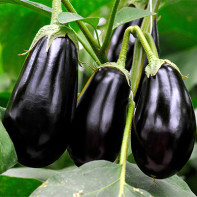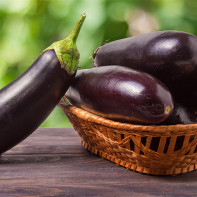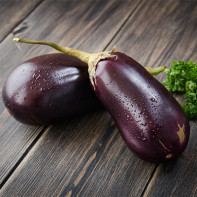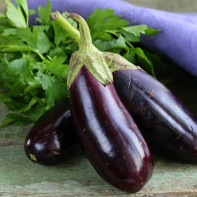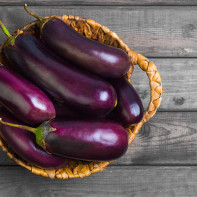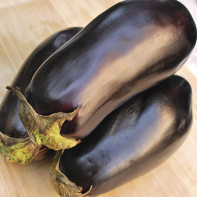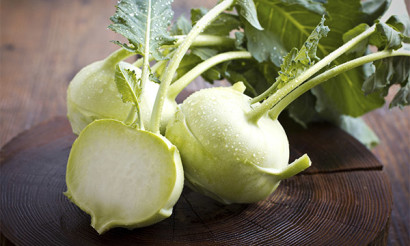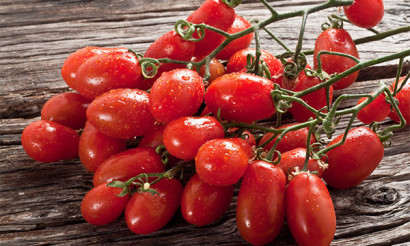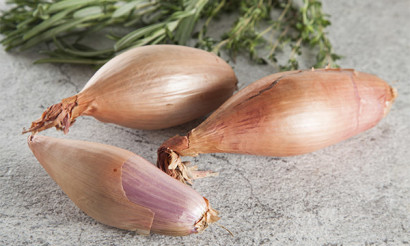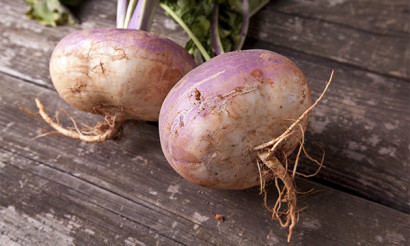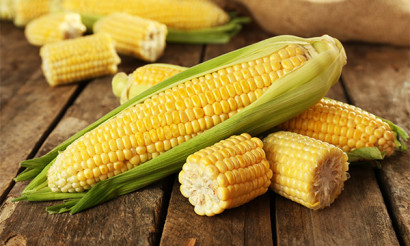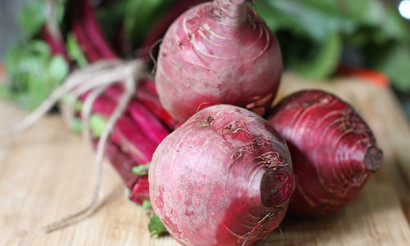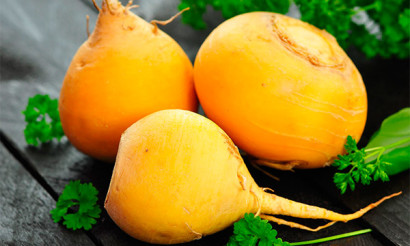Eggplant: composition, beneficial properties and contraindications.
Spicy and tender eggplants have found wide application in cooking. They are stewed, fried, stuffed, made of them produce caviar, make chips and marinate. In addition to its great taste qualities, the fruit is very useful. It is almost always used in diet menus, normalizes metabolism and digestion, is shown to people with vascular diseases and even help to quit smoking, and in a comfortable way.
- What is the difference between eggplant and zucchini
- Composition and calories
- What are the benefits of eggplants
- General benefits
- For Women
- For Men
- In Pregnancy
- For breastfeeding
- For children
- When losing weight
- Eggplant in medicine
- Diabetes mellitus
- For pancreatitis
- For gastritis
- For the bowel
- For constipation
- For gout
- For colitis
- For the liver
- For hemorrhoids
- For cholecystitis
- Eggplant in cosmetology
- Harm and Contraindications
- Can you be poisoned by eggplants?
- How to choose and store eggplants
- Can I Freeze?
- How to cook Eggplants: Recipes
- Soup
- Salad
- Caviar
- Sauté
- Cutlets
- Fritters
- How to Roast
- How to bake in the oven
- How to Braise
- How to marinade
- Do eggplants have to be peeled?
- Can I Eat Them Raw
- How to remove bitterness from eggplants
- Can I Give Eggplants to Animals
- Interesting facts about eggplants
How an eggplant differs from a zucchini
Eggplants can often be confused with zucchini, especially young or green-skinned varieties. The fruits are quite similar in appearance, except for the color and texture of the skin. In the culinary sense, these vegetables are used in similar recipes, and there is a reasonable question - but can they be substituted?
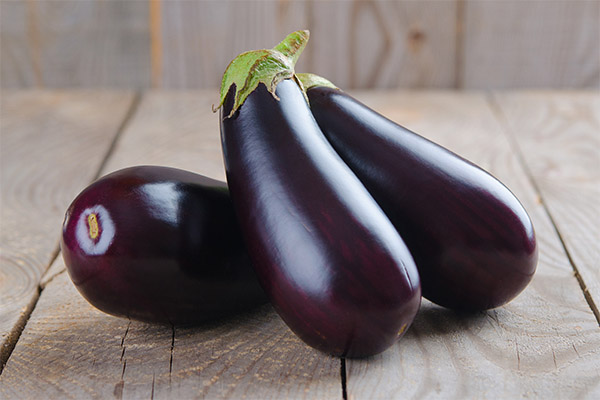
Externally, eggplant has a smooth skin, often dark in color. However, unripe or special varieties may also have a green, but always smooth peel. When cut, the fruit has a light colored flesh with many chaotically arranged small pips.
Zucchinis are elongated, they are always green and have a special skin texture; just run your finger over it to feel the many microvilli. The layer of flesh is homogeneous under the skin, and the seeds are clustered in the center of the fruit. They are easy to remove if necessary.
Both vegetables are actively used in the kitchen, sometimes even together or in similar recipes. However, they have different composition and useful properties, differ in taste and flavor. Thus, eggplant has a lot of potassium, silicon, phosphorus, vitamins B5, B6, B9 and PP. There is a special substance - nasunin, which protects cells from destruction and is especially good for the brain. Zucchini contains a little less potassium, but it has a lot of magnesium, cobalt, iron and manganese, by vitamins - mainly B1, B2, B4, phylloquinone and C.
Composition and calories
Eggplant is an extremely useful vegetable that contains B vitamins, macro- and micronutrients necessary for the body. The high nicotine content will help people who want to quit smoking. Very little caloric content, coupled with the ease of the product for the digestive system make eggplant recommended for use on any, even the most stringent diets. In 100 grams of fruit contains:
- only 24 kcal, which is about 1% of the daily recommended level;
- carbohydrates - 4.5 g;
- fats - 0.1 g;
- proteins - 1.2 g;
- organic acids, 0.2 g;
- ash - 0,5 g;
- water - 91 gr;
- fiber - 2.5 g.
The fruit is rich in vitamins, macro- and micronutrients. By the way, most substances, with the exception of ascorbic acid, decompose slowly during heat treatment. Eggplant loses very few useful substances, even in a long stew. A total of 100 grams of fresh fruit contains:
- vitamin PP - 0.8 mg or 4% of the daily allowance;
- Pyridoxine B6 - 0.15 mg or 8% of the daily requirement;
- Vitamin B5 - 0.28 mg, or 6% of the recommended rate;
- Phylloquinone K - 3.5 µg or 3% of the daily requirement;
- ascorbic acid - 5 mg;
- folate B9 - 18.5 mg or 5% of the daily requirement;
- Potassium - 238 mg or 10% of the recommended daily intake;
- Silicon - 29 mg, the full daily allowance;
- Phosphorus, 34 mg or 5% of the daily allowance;
- Copper - 135 mcg or 13.5% of the required intake;
- Molybdenum - 10 micrograms or 15% of the recommended level;
- Manganese - 210 micrograms or 10% of the daily requirement;
- Cobalt - 1 microgram or 10 percent of the body's needs.
How are eggplants useful?
General benefits
Rich in vitamins and minerals, the fruit is part of almost every diet. They saturate the body with nutrients, satisfy hunger, are easy to digest and at the same time contain almost no calories.

The presence of nasunin in the skin of the fruit is beneficial for cellular function, especially beneficial for the brain. There is a lot of research going on right now about how to reduce Alzheimer's symptoms with regular intake of nasunin. A complex of minerals and vitamins strengthens blood vessels, and there is also a slight decrease in low-density lipoproteins (or harmful cholesterol) when eggplant is eaten systematically.
Light foods rich in fiber stimulate proper intestinal function and normalize digestion. Chlorogenic acid and polyphenols show good results in slowing down the spread of free radicals in the body.
For women.
It is recommended to include stewed or boiled eggplants in the diet. They stimulate metabolic processes in the body, establish the work of the intestines. The fruit is especially useful during strict diets, it will not affect the figure in any way, but it will get rid of the risk of anemia and even relieve chronic fatigue syndrome.
For Men
Since ancient times, eggplant has been used as a mild aphrodisiac. It enhances male strength, raises libido and overall tone. The most effective eggplant caviar, and with the obligatory addition of tomatoes, ginger and chili peppers.
The presence of natural nicotinic acid will be able to relieve the suffering of quitting smoking. Eggplant will replace the substances the body needs, all that remains is to overcome the psychological habit.
When pregnant
Eggplant will fit perfectly into the diet of a pregnant woman. It is a light product that stimulates proper digestion. However, it is only a recommended vegetable, it does not have particularly beneficial properties for the pregnant woman. Although the high amount of potassium, combined with another dish rich in calcium, will significantly help in the development of the fetus.
For pregnant women, it is recommended to eat stewed or steamed eggplant, firm and young, with minimal solanine content. It can significantly worsen the condition, especially against the background of toxicosis.
When breastfeeding.
It is recommended to include eggplants in the diet of a nursing mother, and at least twice a week. It improves metabolism, digestion, has a very mild and comfortable laxative effect.
A nursing mother will get important B vitamins, lots of potassium, with a light product that will not cause problems. However, it is important to choose young and firm fruits, otherwise high doses of solanine can cause severe toxicosis up to short-term cessation of lactation.
For children
Steamed eggplant as part of another dish (a total single dose of up to 30 g) can be given to children from 8 months. The fruit is easily digested even by a child's digestive system, which is not fully formed, and it will gently stimulate it. From 1.5 years old you can give eggplant as a separate dish in fried, stewed, canned or boiled form without any special restrictions.
When losing weight
Regular consumption of eggplant is recommended in diets aimed at weight loss. It is extremely easy for the digestive system, which has only 24 kcal, which is about 1% of the daily rate. Of course, it is not necessary to eat 10 kg of eggplant. However, it is necessary to regularly include the vegetable as part of others or as an independent dish. The recommended weekly norm is up to 6 servings.
Eggplant in medicine
Various varieties have been actively researched for use in medicine or medicine since the 19th century. However, official science now unequivocally recommends including eggplants in diets for various diseases. The therapeutic properties confirmed by studies have not been identified.
Now the main directions are reduced to the isolation and use of nasunin, which protects cells from destruction. There is some justification, which still needs proof, that regular obtainment of this substance helps to reduce the likelihood of developing Alzheimer's disease.
Another study looks at changes in low-density lipoprotein levels with regular consumption of foods that include eggplant. Preliminary studies in a small sample have yielded positive results, but the decrease itself is quite small, less than 5%.
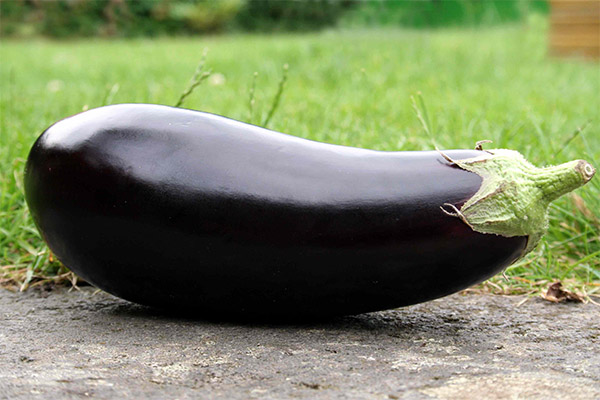
For Diabetes.
Eggplant itself and eggplant-based products are included in the diet of patients with any type of diabetes. The glycemic index of 15 units allows you to consume the fruit almost without restrictions.
B vitamins, as well as potassium and phosphorus are especially useful for diabetic patients, as traditional therapy regimens are governed by a strict diet. However, and eggplant has some additional limitations: it should not be consumed with diabetes and cholecystitis, exacerbation of pancreatitis, kidney stones and ulcers.
For pancreatitis.
Eggplant is used in diets, but the amount and dosage is determined by the doctor. This is an extremely serious disease that requires medication therapy and a strict diet. In acute pancreatitis, eggplant should not be eaten. However, it is one of the easiest foods for the body, so it is prescribed immediately after fasting. With chronic pancreatitis, you can eat stewed, boiled or steamed eggplants.
In gastritis.
The product can be freely used with gastritis at any stage, but only after undergoing heat treatment. There are no substances and elements that can worsen the condition, lead to irritation or ulcers. Quite a small amount of ascorbic acid is almost completely destroyed by stewing or boiling. Eggplant can be consumed up to 200 g per meal.
For the intestines
Eggplant has a very positive effect on the intestines. They are easy to digest and at the same time stimulate peristalsis. The large amount of fiber will save problems with going to the bathroom. Among the contraindications only ulcers. Otherwise, you can consume up to 5 kg of fruit per week.
Useful vitamins and minerals in general have a beneficial effect on the whole body. The intestines receive the necessary micronutrients, which prevent the development of serious malfunctions.
With constipation
Eggplant does not have a pronounced laxative effect. However, it is extremely easy to digest, which has dietary fiber. The digestive system and intestines are stimulated. Everything starts to work, stagnant processes disappear. This leads to the normalization of trips to the toilet. Therefore, in chronic constipation and it is recommended to use eggplant as a very mild and delicate laxative. And it should be included in the diet at least 4 times a week.
In case of gout
The main problem of the disease is that purines accumulate in the body. The acid crystallizes on the surfaces of the joints and causes excruciating painful attacks. Eggplant does not have any substances that provoke the formation of purines. Eating it regularly stimulates the excretion of sodium urates, another problematic element that causes acid crystallization.
In colitis.
Colitis is a serious disorder in the body and should be diagnosed. Initially, fasting or moderate inclusion of fast carbohydrates like honey is recommended. It is necessary to determine the type of disorder and form a diet based on it.
Eggplant, like any food, can lead to severe complications in undiagnosed colitis. Subsequently, the doctor may include steamed or baked eggplant in the diet. Heat treatment is extremely important, you should add another 10-15% cooking time to the recommended in the recipe.
For the liver
Eggplant is included in diets for liver disease. They are extremely easy to digest and can replace more complex and heavy foods. This reduces the overall burden on the body. The presence of copper, cobalt, manganese is essential for liver repair. Eggplant is the lightest food that can provide these elements.
At the same time, scientific studies have not confirmed the hepatoprotective capabilities in any form of cooking. Now the product is considered exclusively as an auxiliary, but one of the main ones in diets for liver diseases.
In hemorrhoids.
A pronounced effect on hemorrhoids from the eggplant diet has not been achieved. However, this fruit is recommended for systematic consumption at least 4 times a week. The effect goes in two directions at once:
- Normalization of gastrointestinal function, softening of stool and as a consequence less damage to the hemorrhoidal nodes.
- General strengthening of the walls of blood vessels, including in the hemorrhoidal node, which reduces the number of ruptures and bleeding.
In cholecystitis.
Nutritionists prescribe to limit the consumption of eggplant in cholecystitis. Usually it is recommended to 1-2 intakes per week, in total - less than 500 g of eggplant.
The problem lies in the weak choleretic effect, which will lead to stagnation and the formation of more stones. The disease requires diagnosis, and already on the basis of this, a diet is prescribed, corresponding to the specific condition of the gallbladder, the nature of the stagnation and the size of the stones.
Eggplant in cosmetology
The juice and pulp of the fruit contributes to the production of natural collagen, which helps to make the skin firm, smooth out micro-wrinkles and restore youthfulness. It is on this property that the main use of eggplant in cosmetology is based.
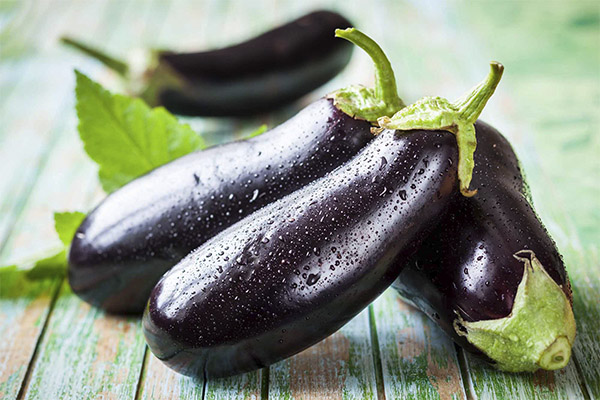
- Mask for problematic skin. Pour boiling water over grated eggplant without peel and leave it to infuse in a closed bowl for 5-7 minutes, then drain the water. In a mask using a pulp of fruit. Dilute a tablespoon of nonfat sour cream to a thick mass. With this mixture cover the face for 10-12 minutes, then rinse with cool water.
- Anti-wrinkle mask. Grind a small piece of eggplant without peel in a blender or on a fine grater and then add a teaspoon of aloe juice. Let the mixture infuse for 5 minutes, and then apply it to your face. Hold the mask for 15 minutes, then rinse with water. To achieve the effect, the procedure should be daily with one random weekend a week.
- Moisturizing and rejuvenating mask. Using a sharp knife or potato cutter, cut thin strips of fruit without peel. Put them on your face and cover them with a gauze cloth. After 10 minutes remove the eggplant strips and wash with mineral water or slightly warm milk.
- Nourishing mask for all skin types. Mashed potato eggplants without peel into a purée; 1.5 tablespoons is enough for a mask. Add 10 grams of honey, a tea spoonful of aloe vera and 25 ml of St. John's wort. Mix everything. A part, about half, apply at once a very thin layer to the face. After 3-4 minutes the skin will absorb this mask, then apply the remaining mass. After 10 minutes, wash off the rest with warm water.
Hazards and contraindications
Eggplant is well digested by the body, properly cooked dish does not carry any harm. However, there are some limitations. You should refrain from eating or consult a doctor:
- In colitis;
- cholecystitis;
- low levels of iron in the body;
- kidney stones;
- acute arthritis;
- allergies to nightshades.
Eggplant contains only one potentially dangerous substance: solanine. It is the reason why you should not eat green potatoes. The highest content of this organic compound is in soft, overripe fruits. Therefore, you should choose firm and young eggplants. The remaining alkaloids and acids are not harmful to the human body. The fruit can even be eaten raw, but it is not very tasty in this form.
Is it possible to be poisoned by eggplants
It is realistic to earn only mild poisoning, which is characterized by headache, diarrhea, temporary disorientation, an increase in temperature to 38 degrees and nausea without vomiting. This will require eating several pounds of overripe eggplant with minimal heat treatment at a time. The longer the fruit is stewed, boiled, or fried, the less solanine remains.
A lethal dose of 0.5 g/kg of body is theoretically unattainable. Only cases of severe poisoning with unripe black nightshade berries, where the concentration of this alkaloid is three hundred times higher than in eggplants, have been recorded.
How to choose and store eggplants
The best fruits are only from the garden. Freshness is very important for eggplant, because over time, some of the useful substances are destroyed and the concentration of harmful solanine increases. Choosing a fresh and tasty fruit is quite simple, here are the basic rules:
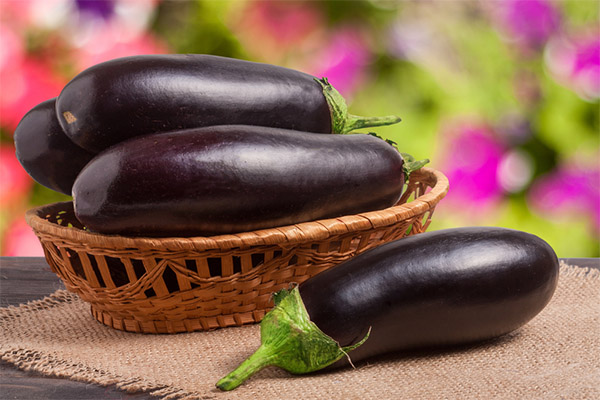
- Eggplant should have a green, not shriveled fruit stalk.
- It is better to choose medium-sized fruits, they are the most useful.
- The skin should be smooth and single-colored or with a smooth shimmer of color.
- Always use a universal test - press on the fruit, if the dent remains fixed - it means the fruit is old, and it is not recommended to buy it.
Fresh fruit can stay in a cool place for up to a month. However, every day processes will go on inside, reducing the fruit's usefulness and producing harmful solanine.
Eggplants are good to dry and can then be stored through the summer. However, the process will lead to a loss of appearance. It is no longer possible to serve a beautiful dish with even slices of eggplant.
You can freeze both the vegetable itself after heat treatment, and the finished dish, such as whole baked eggplants. They will retain their flavor and aroma for 5-7 months at a storage temperature of -18 degrees.
However, the best way to save eggplants until next summer is canning. There are many techniques - lecho, pickling, pickling, and souring.
Can I Freeze
Eggplant freezes well, but if you freeze the fruit fresh in closed containers, after a while the product will be bitter and the consistency will become sticky, rubbery. And no culinary tricks can get rid of these troubles.
Only fruits that have been thermally processed can be frozen. Frying, stewing, blanching, and baking are all suitable. You can not bring it to readiness, for example, slices of fruit is enough to fry until light golden 2-3 minutes on each side, and when baked at 180 degrees enough and half an hour.
Important container: so that the eggplants do not spoil, you need to put them in special airtight containers or bags under the vacuum cleaner.
How to cook eggplants well: Recipes
Eggplant is actively used in national cuisines, they are the basis for many culinary masterpieces. Preparation is sometimes quite simple, and it comes out very tasty and useful. For example, you can quickly prepare Bulgarian-style moussaka. Fragrant fruits will be baked with minced meat, spices and cheese sauce. For cooking, you need the following products:
- two medium eggplants;
- one tomato;
- two potatoes;
- minced meat;
- one egg;
- one tablespoon of sour cream;
- hard cheese;
- dried basil;
- dill;
- allspice;
- salt.
Restaurant serving - in the form of rolls. To do this, the eggplants are thinly sliced and salted for 10 minutes, so that the bitterness is gone. Homemade serving is a little like meat à la française, here it is enough to cut all the vegetables into circles, and remove the bitterness from the eggplants with salt.
Take a deep baking dish, put sliced potatoes down. It will absorb all the juices and become fantastically delicious. Then there are differences in preparation: for restaurant serving, you need to roll up the eggplants with stuffing and put each one on a slice of tomato, for home serving - just lay out layers of tomatoes - stuffing - eggplants - stuffing - eggplants. Each layer a little pepper, salt and add a little spice.
Put in the oven at 180 degrees for 15 minutes with a splash of oil. Beat the sour cream and eggs, pour the rest of the spices and add to the already heated dish, pouring it on top. Bake for another 40 minutes. Then sprinkle with cheese and send to the oven for 10 minutes. Flavorful, tasty, rich and nutritious moussaka is ready, before serving you can sprinkle with herbs.
Soup
Eggplant is a part of many recipes. However, their taste is most revealed in a simple and very tasty summer soup. This is a dish of Russian cuisine, which will require only the most accessible ingredients. Products needed:
- one medium eggplant;
- one tomato;
- one onion;
- two potatoes;
- One bell bell pepper, preferably red;
- one tablespoon of flour;
- coriander greens;
- hopely suneli;
- bay leaf;
- a liter of water, or preferably chicken broth, you can even from cubes;
- a little vegetable oil;
- pepper and salt.
Cut eggplants into half-centimeter-thick slices and roll in flour. Fry in vegetable oil on both sides until golden. Then place on a paper towel to remove excess oil.
Peel the tomato, just cut it crosswise and boil it in boiling water, and then put it in cold water.
Put the potatoes, cut into small cubes, and add a bay leaf to boil them. It is desirable to use chicken broth. Even from the cube will come out much tastier than just on water. Boil the potatoes for 5 minutes after boiling. During this time, cut peppers into small cubes, and onions - in half rings, so they do not break up into mush when boiling for a long time.
After 5 minutes, add the onions and bell peppers to the potatoes, letting the mass slowly simmer for another 5 minutes, then send there the tomato slices. Chop the roasted eggplant into the preferred pieces in the soup and transfer it to the pot after 5 minutes.
Twenty minutes after the first boil, remove the bay leaf, add chopped coriander, pepper, salt, you can squeeze through a garlic clove. Heat the pot over high heat for a minute, cover and leave to infuse for 15 minutes. Fragrant, very rich and delicious soup is ready to serve.
Salad
Baked or roasted eggplant is an integral part of many salads. It gives them a special flavor and richness, can replace meat, making the salad more dietary. To prepare a standard salad, you will need the following products:
- one eggplant;
- one bell bell pepper;
- two tomatoes;
- olive oil;
- fresh coriander;
- lettuce leaf;
- salt and seasoning.
Cut eggplants into slices or portions and fry in a pan until golden. Thin slices are enough for 2-3 minutes on each side, cubes need a little more. Transfer to a paper towel, let them rest and give up excess oil.
Cut tomatoes and peppers into portioned salad slices. Finely chop the cilantro. Add seasonings, a ready-made Italian herb mix works well. Put the cooled eggplants on a plate and mix everything thoroughly, add a few fresh lettuce leaves on the side and serve.
Caviar
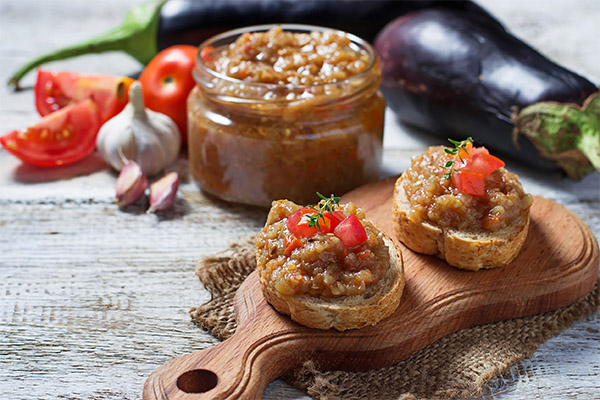
The most popular dish is eggplant caviar, you can even find it on store shelves. But the taste there leaves much to be desired, and why buy, if you can make much more flavorful and interesting yourself. For the simplest recipe, the following products are enough:
- two eggplants;
- two tomatoes;
- sweet bell pepper;
- four garlic cloves;
- One onion, preferably red;
- cilantro;
- 100 ml of vegetable oil;
- salt.
Prepare the whole vegetables and place them on a greased baking tray with vegetable oil. In one group go eggplants, next to peppers and aside tomatoes. Preheat the oven to 180 degrees and place the vegetables for 10 minutes. Remove the peppers and tomatoes, leaving the eggplants to roast for another 15 to 20 minutes, depending on the size of the fruit.
Open the peppers and remove the seeds and stalks, preferably remove the skin for absolute tenderness. Remove the skin from the tomatoes, especially since after baking they will come off on their own.
Take the ready eggplants out of the oven, cut them in half and scrape out the pulp with a tablespoon. Much depends on the desired serving. The easiest way is to use a blender to chop, but then everything will turn into a puree. If you want a restaurant look, use a sharp knife to chop the tomatoes, peppers and onions. Eggplant flesh can be crushed with a grinder or spoon. Add grated or crushed garlic, spices, remaining oil and mix everything until homogeneous. After it has infused and cooled for an hour in the fridge, the aromatic and tantalizing caviar is ready to be served.
Sautéed
A dish based on an elegant French recipe is perfect for serving at the holiday table. Products needed:
- four eggplants;
- One onion, preferably red;
- two carrots;
- four tomatoes;
- sweet bell pepper;
- three garlic cloves;
- olive oil - 80 ml;
- salt.
It is important to remove all bitterness using salt for a delicate taste. Eggplant should be cut into slices of 5 mm thickness. Onions and peppers should be sliced evenly, carrots should be passed through a coarse grater, and tomatoes should be scalded with boiling water, remove the skin, and then cut into cubes.
Send the vegetables to stew in vegetable oil. Eggplant is also dry with a towel and put in a pan. They should be fried for 2 minutes on each side until golden.
After half an hour of stewing vegetables add eggplant, more oil, salt, selected spices and mix. Sauté will cook on low heat for another 15-20 minutes. Then serve.
Cutlets
Excellent vegetarian cutlets can be made from eggplant. It will be very tasty, nutritious and without any meat. It comes out especially well with the addition of hard cheese. To prepare fragrant cutlets you will need the following ingredients:
- eggplants - 800 g;
- hard cheese - 100 gr;
- two eggs;
- two garlic cloves;
- 50 ml of milk;
- several slices of loaf;
- breadcrumbs - 50 g;
- vegetable oil;
- green onions;
- parsley.
Cut eggplants into small cubes and fry quickly so that they soften slightly. While they cool, grate cheese, finely chop parsley and a few sprigs of green onion. Soak the loaf or bread in milk.
Pass the cooled eggplant through a meat grinder or blender, then do the same with soaked in milk bread, add grated cheese, garlic, herbs, break both eggs and poured spices. Now you need to mix everything thoroughly until a homogeneous mass. Put the breadcrumbs in a bowl large enough to crumble. It remains only to form cutlets, roll them in breadcrumbs and send them to the frying pan until cooked. A delicious, flavorful and vegetarian dish is ready.
Fritters
You can fry excellent vegetable fritters from eggplants, they are great for a dense breakfast or dinner. Useful and dietary dish served cold or hot, and it is extremely easy to prepare. The following products are needed:
- young eggplants - 200 g;
- zucchini - 100 gr;
- onions - 50 gr;
- garlic - one clove;
- fresh dill - five sprigs;
- egg - 3 pcs;
- flour - 60 gr;
- paprika - 3 g;
- green onions - four quills;
- feta cheese - 100 gr;
- salt;
- pepper.
It is better to use feta, but you can substitute other soft cheese, although the taste will be less expressive.
Grate zucchini and eggplant on a medium grater. To remove the flavors, put the mass in a bowl on a colander, sprinkle with salt, leave for half an hour. Mashed potato the feta with a fork, add finely chopped onion and dill. Garlic can be grated or pressed.
Break the eggs into a separate bowl, beat and add the flour. Pour the cheese, onion and garlic with this mixture. Squeeze the grated vegetables and also add here. Mix all ingredients, add paprika and other spices. Then pour the pancakes onto a heated frying pan with oil. Fry until bright golden on both sides. Delicious and at the same time diet pancakes can be served to the table with nonfat sour cream or Greek yogurt.
How to broil
Eggplant fries very quickly. There are lots of recipes and sauces, you can really experiment a lot. The main rule is not to remove the skin, only it allows you to keep the shape, will not let the mashed potatoes spread on the plate. The simplest and very tasty roasting recipe will require such ingredients:
- two medium eggplants;
- three garlic cloves;
- a little parsley;
- vegetable oil.
To make the dish come out dietary, you need to soak the eggplant slices in salted water for half an hour or an hour. This way the flesh will not absorb the oil from the pan.
Chop the parsley finely, do the same with garlic or grate it on a fine grater. Add oil to a heated frying pan and place eggplant slices. Fry for 3-4 minutes on each side. Before serving, place each slice on a paper towel and remove excess oil. Then transfer to a plate and sprinkle with the garlic and parsley mixture.
How to bake in the oven
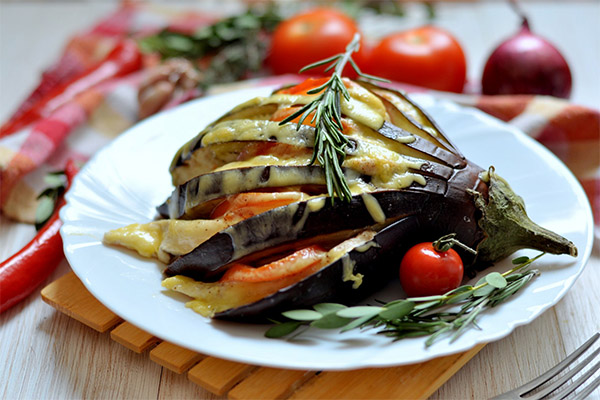
There are many recipes for baking. However, the most popular are stuffed eggplants. They can be combined with mushrooms, meat, various vegetable fillings. For a dietary, but very tasty dish, the following components will be required:
- two eggplants;
- mushrooms - 100 grams;
- one onion;
- a tablespoon of sour cream;
- hard cheese per cap - 50 g;
- half a teaspoon of paprika;
- salt;
- pepper;
- green dill for serving.
Cut the eggplant in half, brush each half with oil, and send everything in the oven at 180 degrees for 15 minutes. This will soften the flesh, allowing some to scrape out under the stuffing.
Cut the onion into thin half rings, the mushrooms - in slices and lightly fry until the blush. Add sour cream, paprika, salt and pepper and mix.
Remove some pulp from the eggplants with a spoon and put the prepared stuffing in it. Put the stuffed eggplant halves in the oven for 15 minutes at 180 degrees, then sprinkle them with cheese and put them back in the oven for 2-3 minutes. The dish is ready to serve.
How to Braise
Stewing is one of the most effective types of cooking eggplant. There are many different recipes and stews. The easiest way to prepare stewed vegetables in just half an hour. To do this, you will need the following products:
- eggplant;
- one tomato;
- one bell bell pepper;
- onion;
- garlic clove;
- one-third of a bundle of herbs;
- tablespoon of oil;
- one teaspoon of vinegar;
- half a teaspoon of sugar;
- pepper and salt.
Finely chop and pass the onion for literally 3 minutes, this will be enough. Next, add chopped julienne bell peppers for 3 minutes, then diced eggplant, after another 5 minutes tomato slices. All this fry in a single saucepan or then transfer to a container for stewing.
Braise under a lid for 5 minutes, and there is no need to add water, as the vegetables will give a lot of juice. Add the spices, vinegar and grated garlic, stir and leave to stew for another 10 minutes. The dish is ready, can be served hot or cold.
How to marinate
Marinated eggplants are especially delicious, they are infused with new flavors. However, many recipes are quite complicated and require a lot of time. There is a special way to make delicious pickled eggplants quickly and easily, you will need the following ingredients:
- one eggplant;
- white dry or semi-dry wine;
- dill;
- garlic;
- olive oil;
- salt;
- sugar.
It is easiest to use the proportions from a liter of wine, to it you need to add a teaspoon of chopped dill, a tablespoon of olive oil, 3 grated cloves of garlic, at least a teaspoon of salt and sugar.
Cut the eggplant into small slices. A heat treatment will be required for quick cooking. Bring a container with wine marinade to a boil and add the eggplant slices, bring it to the boil again, lower the heat and cook for 15 minutes. The dish is ready, it is served cold to the table. By the way, this marinade is suitable for onions and bell peppers, so you can make an assortment right away.
Do the eggplants need to be peeled?
It depends on the final dish and the desired softness. The bitterness is concentrated in the layer under the rind. Young eggplants do not need to be peeled. After heat treatment, the skin is tender and easy to separate in the mouth.
From old eggplants you need to remove the skin, it thickens significantly and becomes tough even after a long stewing.
Much depends on the nature of heat treatment. For example, when frying slices, it is the skin that keeps the flesh from spilling out and holds the neat shape. But in a stew or a delicate roll, the skin is superfluous.
Can we eat them raw?
Technically, you can eat eggplant sliced into thin slices. However, the taste of the raw fruit is very specific and even unpleasant. The bitterness can be eliminated with salt, but still such an eggplant will be unpalatable. Also important is ripeness, old and soft fruits accumulate solanine. It will not be destroyed in the heat treatment, and will enter the body.
But in cooking, the unprocessed vegetable is sometimes used. Thinly sliced slices can go as an addition to vegetable marinades. In Asian cuisine, raw eggplant chips are sometimes served. Thin slices are drizzled with lemon juice, spices are added and infused like this for 5-10 minutes, then the dish is ready to be served.
How to remove bitterness from eggplants
A seemingly perfect fruit, fresh and beautiful, can be very bitter. This is easy to correct, but only in relation to unfrozen eggplant. Regular salt should be used. It will draw out the bitter substances from the fruit along with the extra juice.
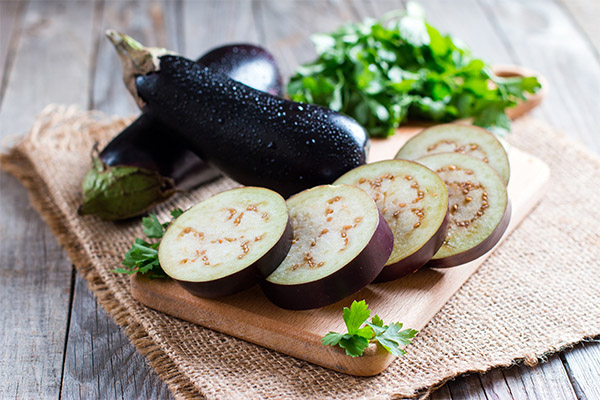
It is necessary to prepare the eggplant in a basic way. For example, if frying is planned - cut into circles, for stew - chop into cubes. Salt solution should be prepared at the rate of one full tablespoon of salt per liter of water. After the salt dissolves, add the eggplants. To prevent them from floating, you need to cover the top with a plate. Keep in the salt solution for 30 minutes, and then rinse with running water.
The second method is more suitable for fruits that need to be baked whole or in large pieces. It is highly recommended to remove the skin. If the skin is necessary in the recipe, you should cut the fruit in half or in large pieces, so that the salt can penetrate into the pulp. Sprinkle the surface of the eggplant with salt for 20-30 minutes. After that, all you need to do is rinse and you can cook.
Can we give animals eggplants?
For dogs and cats, the recommended proportion of vegetables is 20%. Eggplant can also be used as part of this diet. But the animal must not have kidney problems or be allergic to nightshades. As with humans, it is not recommended that they eat the fruit raw. It is better to give it baked or in the form of vegetable stew.
Attention should be paid to the total doses, especially when feeding cats. For them, the fruit can quickly become toxic with the manifestation of mild symptoms of departure, vomiting, diarrhea, lethargy.
Eggplant should not be given to rabbits, they are highly susceptible to solanine. Even a small amount of fresh fruit can cause poisoning.
Interesting facts about eggplants
- It is now proven that eggplants first appeared in India. And they were pear-shaped and with a purple skin.
- By the way, the English name of eggplant is eggplant, which translates as a vegetable egg. The reason is simple, at the time when the English were introduced to the fruit, the most elite and expensive varieties were considered white eggplants in the shape of a large chicken egg.
- Until the 18th century it was popular in Europe to breed different varieties of eggplant, but they were used exclusively as decorative elements, ornaments for the garden or home, but not for eating.
- Eggplant is considered a vegetable, not only in the mind, but also in cooking. However, scientifically it is a seed berry, and the plant's closest relative is the thistle.
«Important: All information on this site is provided for informational purposes only. for educational purposes only. Before applying any recommendations, please consult with a specialist. specialist before using any of the recommendations. Neither the editors nor the authors shall be liable for any possible harm caused by materials."

